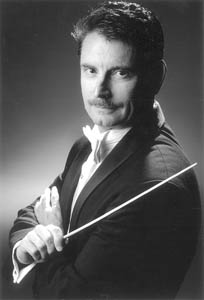![[Metroactive Music]](/music/gifs/music468.gif)
[ Music Index | Santa Cruz Week | SantaCruz Home | Archives ]
Swan Bake
Carl Orff's greatest hit proves a triumph for the Santa Cruz Symphony
By Scott MacClelland
Go figure! It wasn't a Brahms symphony or a Tchaikovsky concerto, but Carmina Burana, Carl Orff's greatest hit, that brought out the biggest audiences of the Santa Cruz Symphony season at last weekend's performances in Santa Cruz and Watsonville. Did I say greatest hit? How about only hit? As far as American audiences are concerned, Orff is a one-trick pony. (Of course no one disputes that CB is a mighty fine pony.)
Larry Granger conducted his orchestra and Cheryl Anderson's Cabrillo Symphonic Chorus (and children's chorus) in a spirited revival of the 1937 "scenic cantata" Sunday afternoon at the Mello Center and got the lion's share of a standing ovation in return. Why does this one-hour symphonic choral work--which is concerned primarily with medieval earthly pleasures, and was composed in Germany under the Nazi regime--hold such seemingly universal appeal? And why to the exclusion of everything else Orff composed?
The answer lies largely in the fact that its allure extends to both sides of the proscenium. More than a concert piece, Carmina Burana has become a ritual excitement for the orchestral musician as well as the chorister, adult and child alike. No one seemed to notice that, as the only work on the program, there could easily have been a good 25 minutes of additional music to fill up a two-hour concert. (In a couple of weeks, Mitchell Sardou Klein is doing Carmina Burana with his Peninsula Symphony on a program that also contains works by Arthur Bliss and David Miller.) But what about the rest of Orff's output? He was actually quite prolific, writing the companion Catulli carmina (on erotic poems of Catullus) and "scenic concerto" Trionfo di Afrodite, which recounts an ancient Greek wedding in 'triumphant' terms. He also wrote operas and theater pieces, and created an extensive teaching method--including original rhymes, songs, marches and dances--for enticing children into music with simple hands-on techniques.
Indeed, the key to Carmina Burana is its simplicity. Melodies and harmonies rarely wander far from the basic tonal triad. Rhythm, which supplies the driving force, builds its complexity from simplicity, cleverly syncopates and occasionally alternates meters, three against four, for example. For all its ritual procession, however, Orff leaves generous room for interpretive latitude, especially in the solo scenes for baritone, soprano and tenor. For his part, Granger had a keen hold on the proceedings, shaping and shading with clear directions from the podium, and paying close attention to the soloists, who all came through with excellent focus and effect. Respectively, they were David Cox, Aimee Puentes and J. Raymond Meyers, each required by the score to survey the highest reaches of their range. Cox had the biggest job, carrying several scenes, not least the swaggering barroom role as the Abbot of Cockaigne. Later he rose into falsetto to reach the tenor range Orff calls for, compensating for the stressful vocal demands by physical presence and force of personality.
Puentes conveyed her charms with a clear, soaring soprano (and shimmering silver gown), seducing any holdouts with the gorgeous, submissive "In trutina." Meyers' single scene, as the swan roasting on the spit, was suitably piteous but always musical, right up into the vocal stratosphere, memorably echoing Orff's unique definition of swan song.
The chorus was garbed in imagined medieval costumes, many adorned in spring flowers, and only wanted more power and theatrical impact in the loud, declamatory scenes. The children, divided into "Con brio" and "Dolce" components, carried their parts in true and winning style. Orchestral pianist Rae Imamura and bassoonist Jane Orzel deserve special acknowledgment for carrying off their crucial assignments with strength and panache.
Copyright © Metro Publishing Inc. Maintained by Boulevards New Media.
![]()

Bore Us, Carl Orff? Hell no! Conductor Larry Granger knew 'Carmina Burana' would be perfect for the SC Symphony.
From the May 7-14, 2003 issue of Metro Santa Cruz.